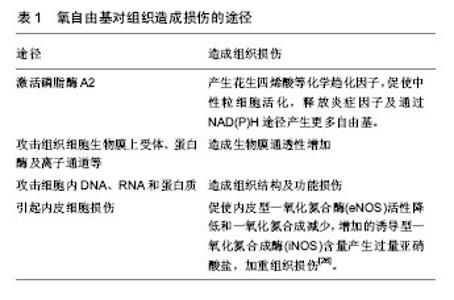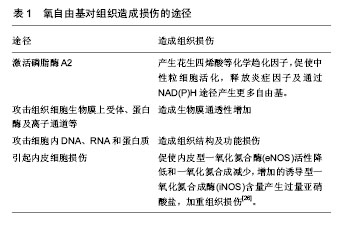Chinese Journal of Tissue Engineering Research ›› 2019, Vol. 23 ›› Issue (7): 1129-1135.doi: 10.3969/j.issn.2095-4344.1077
Previous Articles Next Articles
Research progress of ginsenosides Rb1 in flap ischemia/reperfusion injury
Cao Chang, Ren Xiaoyan, Meng Fanjun, Cheng Fengrui, Cen Ying
- (Department of Plastic Surgery and Burns, West China Hospital, Sichuan University, Chengdu 610061, Sichuan Province, China)
-
Received:2018-10-07Online:2019-03-08Published:2019-03-08 -
Contact:Cen Ying, Professor, Department of Plastic Surgery and Burns, West China Hospital, Sichuan University, Chengdu 610061, Sichuan Province, China -
About author:Cao Chang, MD, Associate chief physician, Department of Plastic Surgery and Burns, West China Hospital, Sichuan University, Chengdu 610061, Sichuan Province, China -
Supported by:the Science and Technology Program of Sichuan Province, No. 2015SZ0160 (to CC)
CLC Number:
Cite this article
Cao Chang, Ren Xiaoyan, Meng Fanjun, Cheng Fengrui, Cen Ying. Research progress of ginsenosides Rb1 in flap ischemia/reperfusion injury[J]. Chinese Journal of Tissue Engineering Research, 2019, 23(7): 1129-1135.
share this article

2.1 人参皂苷Rb1的药理作用 人参是名贵补益类中药,其化学成分复杂,药理作用广泛。人参中的皂苷类成分被认为是人参中的主要有效物质,约占人参中成分的4%。人参皂苷根据皂苷元的不同,被分为二醇类皂苷、三醇类皂苷和齐墩果酸类皂苷。人参皂苷不仅广泛存在于人参的根、茎、叶、花、果实、种子中,还存在于红参、高丽参、西洋参、三七、绞股蓝等植物中[13]。人参皂苷Rb1属于二醇型皂苷,在40多种人参皂苷中含量最高,是人参发挥药效的主要成分,一直是中外学者研究的热点。人参皂苷Rb1具有显著的清除自由基、抗炎、抗凋亡、降血糖、抗肿瘤、促进性功能及提高免疫力等作用。人参皂苷Rb1在中枢神经系统中可发挥促智、神经损伤修复、脑缺血保护作;在心血管系统中发挥抗心肌凋亡、保护血管内皮细胞能作用[14]。大量动物实验研究已证实人参皂苷Rb1对脑、心、肝、肾、肠、皮瓣的缺血再灌注损伤都具有较好的保护作用[14-19]。 2.2 人参皂苷Rb1减轻组织器官缺血再灌注的研究进展 20世纪60年代,研究人员发现缺血组织或器官恢复血供后,将出现更加严重的损伤,并将此种现象定义为缺血再灌注损伤。皮瓣转移过程中,打破血流稳态,皮瓣将经历缺血缺氧过程,恢复血供后,将出现明显缺血再灌注损伤,理解皮瓣缺血再灌注损伤机制,有助于发现减轻皮瓣缺血再灌注损伤方法。研究表明缺血再灌注损伤是缺血组织或器官恢复血供后出现的一种复杂的非特异性损伤级联反应,多种因素促进缺血再灌注损伤的发生发展,主要涉及过量的氧自由基生成、炎症细胞激活浸润及其与内皮相互作用、能量衰竭、细胞内钙超载、一氧化氮生成、细胞凋亡等方面[1,15,20-21]。 不同组织器官耐缺血不同,皮瓣对缺血耐受性更好。皮瓣缺血再灌注损伤机制与人参皂苷Rb1的作用机制可能与其抗氧化、抑制炎症反应、增加一氧化氮合成、抗凋亡、抑制钙超载等作用相关。 2.2.1 清除氧自由基、抑制脂质过氧化作用 再灌注期间氧自由基过量生成是皮瓣缺血再灌注损伤中重要的致病因素。机体正常情况下可产生少量氧自由基,与体内抗氧化物质处于动态平衡,不会对机体造成损伤。当皮瓣处于缺血状态,细胞氧利用能力下降,引起有氧代谢障碍。此时氧原子失去了一个电子变成了具有可攻击细胞的活性氧自由基(ROS),包括超氧阴离子、羟自由基等多种过氧化物,从而引发了一系列对细胞具有破坏性的过氧化反应。血流恢复灌注后,不仅没有减轻皮瓣的缺血缺氧状态,反而还提供了制造大量活性氧自由基的原料,导致细胞内大量的氧转化成活性氧自由基。活性氧自由基具有极其活泼的化学性质,可通过中间链式反应,不断形成新的自由基对组织造成损伤[22]。 移植皮瓣发生缺血再灌注时,氧自由基的产生显著增多,机体抗氧化物质大量消耗,打破了机体自由基与抗氧化物质的动态平衡,进而通过氧化反应氧化细胞中脂质、蛋白质、核酸等成分引起细胞结构和功能损伤[23]。目前已知的活性氧自由基主要通过内皮细胞黄嘌呤氧化酶途径和中性粒细胞烟酰胺腺嘌呤二核苷酸磷酸还原酶(NADPH)两种途径造成皮瓣缺血-再灌注损伤。皮瓣组织缺血缺氧时一方面钙离子依赖性蛋白酶被激活,刺激黄嘌呤脱氢酶转化为黄嘌呤氧化酶;另一方面大量次黄嘌呤堆积,经黄嘌呤氧化酶氧化作用形成黄嘌呤,继而黄嘌呤氧化酶再催化黄嘌呤转化为尿酸[24]。 除此之外,相关研究表明在线粒体缺血期可出现琥珀酸异常堆积,是再灌注初期自由基大量生成的启动因素[25]。缺血组织可从苹果酸-d冬氨酸穿梭(MAS)及嘌呤核糖循环(PNC)中产生大量延胡索酸,在琥珀酸脱氢酶逆向催化下生成琥珀酸。氧自由基还可通过以下途径对组织造成损伤:见表1。"

| [1] Schmidt Y, Bannasch H, Eisenhardt SU. Ischemia-reperfusion injury leads to significant tissue damage in free flap surgery. Plast Reconstr Surg. 2012;129(1):174e-175e. [2] 吴小蔚,陕声国,李爱林,等.中性粒细胞在岛状肌皮瓣缺血再灌注损伤中的作用及NO干预[J].武汉大学学报(医学版). 2001;22(2): 109-111.[3] Zhang F, Hu EC, Gerzenshtein J, Lei MP, et al. , The expression of proinflammatory cytokines in the rat muscle flap with ischemia-reperfusion injury. Ann Plast Surg. 2005;54(3): 313-317. [4] Ju J, Wu J, Hou R.Role of the p38 mitogen‐activated protein kinase signaling pathway in estrogen‐mediated protection following flap ischemia‐reperfusion injury. Cell Biochem Funct. 2016;34(7):522-530. [5] Zhang F, Hu EC, Topp S,et al.Proinflammatory cytokines gene expression in skin flaps with arterial and venous ischemia in rats. J Reconstr Microsurg. 2006;22(8):641-647. [6] Wang Y, Orbay H, Huang C, et al.Preclinical efficacy of slow-release bFGF in ischemia-reperfusion injury in a Dorsal Island skin flap model. J Reconstr Microsurg. 2013;29(5): 341-346. [7] Eisenhardt SU, Schmidt Y, Karaxha G, et al. Monitoring molecular changes induced by ischemia/reperfusion in human free muscle flap tissue samples. Ann Plast Surg. 2012;68(2):202-208. [8] Menger MD, Laschke MW, Amon M, et al. Experimental models to study microcirculatory dysfunction in muscle ischemia-reperfusion and osteomyocutaneous flap transfer. Langenbecks Arch Surg. 2003;388(5):281-290. [9] Guo K, Ma J, Liang W. Effects of SB202190 on expression levels of IL-6 and NF-κB in flap ischemia-reperfusion injury. Exp Ther Med. 2018;16(3):2522-2526. [10] 陈拓,王荣春,林仕彬,等.抑制P38MAPK对皮瓣缺血再灌注损伤过程中炎症因子、细胞凋亡的影响[J].海南医学院学报, 2017, 23(5):577-580.[11] 顾文奇,张巍,柴益民.利多卡因对大鼠皮瓣缺血-再灌注损伤的保护作用[J].2010,31(2):125-127. [12] Wu X, Yu M, Li A. Protective effect of a nuclear factor-kappaB inhibitor on ischemia-reperfusion injury in a rat epigastric flap model. J Reconstr Microsurg. 2008 Jul;24(5):351-359. [13] 王海南.人参皂苷药理研究进展[J].中国临床药理学与治疗学,2006,11(11):1201-1206.[14] 杨秋娅,李晓宇,刘皋林.人参皂苷Rb1的药理作用研究进展[J].中国药学杂志,2013,48(15):1233-1237.[15] He F, Guo R, Wu SL, et al. Protective effects of ginsenoside Rb1 on human umbilical vein endothelial cells in vitro. J Cardiovasc Pharmacol. 2007;50(3):314-320. [16] Wu Y, Xia ZY, Dou J, et al.Protective effect of ginsenoside Rb1 against myocardial ischemia/reperfusion injury in streptozotocin-induced diabetic rats. Molecular Biology Reports.2011;38(7): 4327-4335. [17] Sun Q, Meng QT, Jiang Y,et al.Protective Effect of Ginsenoside Rb1 against Intestinal Ischemia-Reperfusion Induced Acute Renal Injury in Mice. Plos One.2013;8(12): e80859. [18] Lu T, Jiang Y, Zhou Z, et al.Intranasal ginsenoside Rb1 targets the brain and ameliorates cerebral ischemia/ reperfusion injury in rats. Biol Pharm Bull. 2011;34(8): 1319-1324. [19] Wang Z, Li M, Wu WK, et al.Ginsenoside Rb1 preconditioning protects against myocardial infarction after regional ischemia and reperfusion by activation of phosphatidylinositol-3-kinase signal transduction. Cardiovasc Drugs Ther. 2008;22(6): 443-452. [20] Sewerynek E, Reiter RJ, Melchiorri D,et al. Oxidative damage in the liver induced by ischemia-reperfusion: protection by melatonin. Hepatogastroenterology. 1996;43(10):898-905. [21] de Perrot M, Liu M, Waddell TK, et al. , Ischemia-reperfusion-induced lung injury. Am J Respir Crit Care Med.2003;167(4): 490-511. [22] Lee YK, Nata'atmaja BS, Kim BH, et al. Protective effect of telomerase-based 16-mer peptide vaccine (GV1001) on inferior epigastric island skin flap survivability in ischaemia-reperfusion injury rat model. J Plast Surg Hand Surg.2017;51(3): 1-7. [23] Lan L, Nakajima S, Wei L, et al.Novel method for site-specific induction of oxidative DNA damage reveals differences in recruitment of repair proteins to heterochromatin and euchromatin. Nucleic Acids Res. 2014 Feb;42(4):2330-2345. [24] Medling BD, Bueno R, Chambers C, et al. The Effect of Vitamin E Succinate on Ischemia Reperfusion Injury. Hand. 2010;5(1):60-64. [25] Chouchani ET, Pell VR, Gaude E, et al.Ischaemic accumulation of succinate controls reperfusion injury through mitochondrial ROS.Nature. 2014;515(7527):431-435. [26] 顾文奇,张巍,柴益民.皮瓣缺血 -再灌注损伤的治疗[J]. 中国修复重建外科杂志, 2011,25(3): 373. [27] Mashima R, Okuyama T. Okuyama, The role of lipoxygenases in pathophysiology; new insights and future perspectives. Redox Biology.2015;6: 297-310. [28] Zhuang CL, Mao XY, Liu S, et al.Ginsenoside Rb1 improves postoperative fatigue syndrome by reducing skeletal muscle oxidative stress through activation of the PI3K/Akt/Nrf2 pathway in aged rats. Eur J Pharmacol. 2014;740:480-487. [29] 谢薇,夏凌辉,方峻,等.人参皂苷Rb1对人脐静脉内皮细胞一氧化氮释放和TGF-β1表达的影响及意义[J].中国医院药学杂志, 2007,27(9):1225-1228.[30] 刘俊伟,任冶龙,刘旭玲,等.人参皂苷Rb1对大鼠局灶性脑缺血再灌注损伤后脑梗死体积及脑组织和血清IL-1β的影响[J].中国中西医结合杂志,2013.33(12):1696-1700.[31] 冷雪,张立德,贾连群,等.人参皂苷Rb_1对异丙肾上腺素诱导大鼠急性心肌缺血影响的作用机制[J].中国实验方剂学杂志, 2015, 21(24):104-108.[32] 李文澜,夏中元,孙倩,等.人参皂苷Rb1对肠缺血再灌注致肾损伤的影响及其机制[J].中华实验外科杂志, 2015.32(11): 2715-2717.[33] Heng Y, Zhang QS, Mu Z, et al.Ginsenoside Rg1 attenuates motor impairment and neuroinflammation in the MPTP-probenecid-induced parkinsonism mouse model by targeting α-synuclein abnormalities in the substantia nigra. Toxicol Lett. 2016;243:7-21. [34] Kitts DD, Wijewickreme AN, Hu C. Antioxidant properties of a North American ginseng extract. Mol Cell Biochem. 2000; 203(1-2):1-10. [35] 曹畅,李棋,岑瑛.大鼠背部超长原位回植皮瓣成活:人参皂甙Rb1影响的验证[J].中国组织工程研究, 2010,14(18):3339-3342.[36] 吴建龙,巨积辉,周广良,等,雌二醇对皮瓣缺血再灌注损伤治疗作用的影响[J].中华显微外科杂志,2014(6):582-585.[37] Wang J, Min P, Grassetti L, et al.Preliminary Outcomes of Distal IMAP and SEAP Flaps for the Treatment of Unstable Keloids Subject to Recurrent Inflammation and Infections in the Lower Sternal and Upper Abdominal Areas. J Reconstr Microsurg. 2015;31(9):621-630. [38] Grambow E, Augustin VA, Strüder D, et al.The effects of hydrogen sulfide on microvascular circulation in the axial pattern flap ear model in hairless mice. Microvasc Res. 2018 ;120:74-83. [39] Wang J, Qiao L, Li Y, et al. Ginsenoside Rb1 attenuates intestinal ischemia-reperfusion- induced liver injury by inhibiting NF-kappaB activation. Exp Mol Med. 2008;40(6): 686-698. [40] Su P, Du S, Li H, et al.Notoginsenoside R1 inhibits oxidized low-density lipoprotein induced inflammatory cytokines production in human endothelial EA. Eur J Pharmacol. 2016;770:9-15. [41] 刘舒, 吕金晓 ,郑蓓诗,等.人参皂苷Rb1改善术后疲劳综合征大鼠中枢炎症反应的机制研究[J].中草药,2015.46(14):2104-2110.[42] 余录,胡光强,陈碧琼,等.人参皂苷Rb1对大鼠脑缺血再灌注JAK2/STAT3信号转导通路的影响[J].重庆医学, 2013.42(17): 1932-1934.[43] Kuo YR, Wang FS, Jeng SF, et al. Nitrosoglutathione promotes flap survival via suppression of reperfusion injury-induced superoxide and inducible nitric oxide synthase induction. J Trauma. 2004;57(5):1025-1031. [44] 陈静,庄洪兴,韩娟,等.左旋精氨酸对岛状皮瓣缺血再灌注后微循环的影响[J].南方医科大学学报,2005;25(7):871-873.[45] Roth E. The impact of L-arginine-nitric oxide metabolism on ischemia/reperfusion injury. Curr Opin Clin Nutr Metab Care. 1998;1(1):97-99. [46] 林威威,施小彤,谢永果,等.肢体远程与局部缺血预处理对大鼠背阔肌肌皮瓣缺血再灌注损伤影响的比较[J].山东医药, 2017, 57(26):35-37.[47] Xia R, Zhao B, Wu Y, et al.Ginsenoside Rb1 preconditioning enhances eNOS expression and attenuates myocardial ischemia/reperfusion injury in diabetic rats. J Biomed Biotechnol. 2011;2011:767930.[48] 曾庆华,战术,张文杰,等.人参皂甙单体Rb_1对豚鼠心肌细胞ICa~(2+)电流阻滞作用的研究[J].吉林大学学报(医学版), 1997, (3):265-267.[49] 王超臣,徐玉彬,张培建.线粒体自噬在缺血再灌注损伤中的研究进展[J].国际外科学杂志,2016,43(3):214-216.[50] Ling H, Gray CB, Zambon AC,et al. Ca2+/Calmodulin- Dependent Protein Kinase II δ Mediates Myocardial Ischemia/Reperfusion Injury Through Nuclear Factor-κB. Circ Res. 2013;112(6):935-944. [51] Radi ZA, Kehrli ME Jr, Ackermann MR. Ackermann, Cell Adhesion Molecules, Leukocyte Trafficking, and Strategies to Reduce Leukocyte Infiltration. J Vet Intern Med. 2001;15(6): 516- 529. [52] Jiang XY, Zhang JT, Shi CZ. [Mechanism of action of ginsenoside Rb1 in decreasing intracellular Ca2+]. Yao Xue Xue Bao. 1996;31(5):321-326. [53] 许浩,葛亚坤,邓同乐,等.人参皂苷Rb1对H_2O_2诱导新生大鼠心肌细胞凋亡的保护作用[J].中国药理学通报, 2005,21(7): 803-806.[54] Song K, Zhang M, Hu J, et al.Methane-rich saline attenuates ischemia/reperfusion injury of abdominal skin flaps in rats via regulating apoptosis level. BMC Surg. 2015;15:92 . [55] Liu YQ, Liu YF, Ma XM, et al. Hydrogen-rich saline attenuates skin ischemia/reperfusion induced apoptosis via regulating Bax/Bcl-2 ratio and ASK-1/JNK pathway. J Plast Reconstr Aesthet Surg. 2015;68(7):e147-156. [56] 宋铁山, 戴开宇,梅劲,等,缺血预处理对大鼠皮瓣缺血再灌注后Bcl-2和Bax基因表达的影响[J].中华显微外科杂志, 2007,30(2): 132-134.[57] Zhao D, Zhang M, Yuan H, et al.Ginsenoside Rb1 protects against spinal cord ischemia-reperfusion injury in rats by downregulating the Bax/Bcl-2 ratio and caspase-3 and p-Ask-1 levels. Exp Mol Pathol. 2018;105(3):229-235. [58] Tatlidede S, McCormack MC, Eberlin KR, et al.A novel murine island skin flap for ischemic preconditioning. J Surg Res. 2009; 154(1):112-117. [59] 胡晓莺,陈振雨.静脉淤血型皮瓣缺血再灌注损伤的研究进展[J].中国美容整形外科杂志,2017,28(4): 241-243.[60] Francis A, Baynosa RC. Hyperbaric Oxygen Therapy for the Compromised Graft or Flap. Adv Wound Care (New Rochelle). 2017;6(1):23-32. [61] Kuo YR, Wang FS, Jeng SF, et al. Nitrosoglutathione improves blood perfusion and flap survival by suppressing iNOS but protecting eNOS expression in the flap vessels after ischemia/reperfusion injury. Surgery.2004;92(4): 53-56. [62] 汪晨净,景志敏.葡萄籽提取物对大鼠心肌缺血再灌注损伤的保护作用[C].中国生理学会第21届全国代表大会暨学术会议, 2002.[63] 周文珍.富氢水对大鼠超长宽比例随意皮瓣存活影响的实验研究[D].大连:大连医科大学,2015.[64] 徐强,司良毅,赵小兰,等,Caspase-3抑制剂对大鼠心肌缺血再灌注损伤后梗死范围的影响[J].第三军医大学学报, 2003.25(16): 1450-1453.[65] 吴小蔚,陕声国,余墨生,等,核因子κB抑制剂对缺血再灌注皮瓣TNF-α和ICAM-1表达的影响[J].中华显微外科杂志, 2005,28(4): 345-346.[66] Gideroglu K, Yilmaz F, Aksoy F, et al. Montelukast Protects Axial Pattern Rat Skin Flaps Against Ischemia/Reperfusion Injury. J Surg Res. 2009;157(2):181-186. |
| [1] | Zhang Tongtong, Wang Zhonghua, Wen Jie, Song Yuxin, Liu Lin. Application of three-dimensional printing model in surgical resection and reconstruction of cervical tumor [J]. Chinese Journal of Tissue Engineering Research, 2021, 25(9): 1335-1339. |
| [2] | Zeng Yanhua, Hao Yanlei. In vitro culture and purification of Schwann cells: a systematic review [J]. Chinese Journal of Tissue Engineering Research, 2021, 25(7): 1135-1141. |
| [3] | Xu Dongzi, Zhang Ting, Ouyang Zhaolian. The global competitive situation of cardiac tissue engineering based on patent analysis [J]. Chinese Journal of Tissue Engineering Research, 2021, 25(5): 807-812. |
| [4] | Wu Zijian, Hu Zhaoduan, Xie Youqiong, Wang Feng, Li Jia, Li Bocun, Cai Guowei, Peng Rui. Three-dimensional printing technology and bone tissue engineering research: literature metrology and visual analysis of research hotspots [J]. Chinese Journal of Tissue Engineering Research, 2021, 25(4): 564-569. |
| [5] | Chang Wenliao, Zhao Jie, Sun Xiaoliang, Wang Kun, Wu Guofeng, Zhou Jian, Li Shuxiang, Sun Han. Material selection, theoretical design and biomimetic function of artificial periosteum [J]. Chinese Journal of Tissue Engineering Research, 2021, 25(4): 600-606. |
| [6] | Liu Fei, Cui Yutao, Liu He. Advantages and problems of local antibiotic delivery system in the treatment of osteomyelitis [J]. Chinese Journal of Tissue Engineering Research, 2021, 25(4): 614-620. |
| [7] | Li Xiaozhuang, Duan Hao, Wang Weizhou, Tang Zhihong, Wang Yanghao, He Fei. Application of bone tissue engineering materials in the treatment of bone defect diseases in vivo [J]. Chinese Journal of Tissue Engineering Research, 2021, 25(4): 626-631. |
| [8] | Zhang Zhenkun, Li Zhe, Li Ya, Wang Yingying, Wang Yaping, Zhou Xinkui, Ma Shanshan, Guan Fangxia. Application of alginate based hydrogels/dressings in wound healing: sustained, dynamic and sequential release [J]. Chinese Journal of Tissue Engineering Research, 2021, 25(4): 638-643. |
| [9] | Chen Jiana, Qiu Yanling, Nie Minhai, Liu Xuqian. Tissue engineering scaffolds in repairing oral and maxillofacial soft tissue defects [J]. Chinese Journal of Tissue Engineering Research, 2021, 25(4): 644-650. |
| [10] | Xing Hao, Zhang Yonghong, Wang Dong. Advantages and disadvantages of repairing large-segment bone defect [J]. Chinese Journal of Tissue Engineering Research, 2021, 25(3): 426-430. |
| [11] | Fan Junchao, Chen Yong, Song Junjie. Sevoflurance combined with xenon pretreatment protects against spinal cord ischemia-reperfusion injury in a rat model [J]. Chinese Journal of Tissue Engineering Research, 2021, 25(23): 3660-3665. |
| [12] | Zhu Rui, Zeng Qing, Huang Guozhi. Ferroptosis and stroke [J]. Chinese Journal of Tissue Engineering Research, 2021, 25(23): 3734-3739. |
| [13] | Chen Siqi, Xian Debin, Xu Rongsheng, Qin Zhongjie, Zhang Lei, Xia Delin. Effects of bone marrow mesenchymal stem cells and human umbilical vein endothelial cells combined with hydroxyapatite-tricalcium phosphate scaffolds on early angiogenesis in skull defect repair in rats [J]. Chinese Journal of Tissue Engineering Research, 2021, 25(22): 3458-3465. |
| [14] | Wang Hao, Chen Mingxue, Li Junkang, Luo Xujiang, Peng Liqing, Li Huo, Huang Bo, Tian Guangzhao, Liu Shuyun, Sui Xiang, Huang Jingxiang, Guo Quanyi, Lu Xiaobo. Decellularized porcine skin matrix for tissue-engineered meniscus scaffold [J]. Chinese Journal of Tissue Engineering Research, 2021, 25(22): 3473-3478. |
| [15] | Mo Jianling, He Shaoru, Feng Bowen, Jian Minqiao, Zhang Xiaohui, Liu Caisheng, Liang Yijing, Liu Yumei, Chen Liang, Zhou Haiyu, Liu Yanhui. Forming prevascularized cell sheets and the expression of angiogenesis-related factors [J]. Chinese Journal of Tissue Engineering Research, 2021, 25(22): 3479-3486. |
| Viewed | ||||||
|
Full text |
|
|||||
|
Abstract |
|
|||||